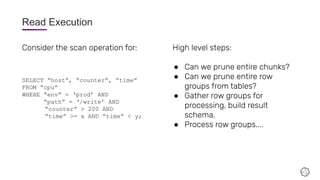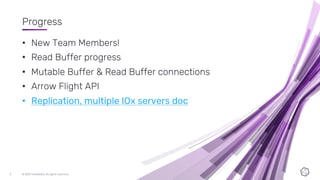InfluxDB IOx Tech Talks: Intro to the InfluxDB IOx Read Buffer - A Read-Optimized In-Memory Query Execution Engine
- 1. Paul Dix InfluxData – CTO & co-founder [email protected] @pauldix InfluxDB IOx - a new columnar time series database (update)
- 2. Progress • New Team Members! • Read Buffer progress • Mutable Buffer & Read Buffer connections • Arrow Flight API • Replication, multiple IOx servers doc
- 3. API Decisions • Management API will be gRPC – CLI for common tasks • Write – InfluxDB 2.0 Line Protocol – JSON objects (events!) – Protobuf? • Query – HTTP (csv, json, display) – Arrow Flight – Postgres?
- 4. What’s Next? • Management API • Parquet Persistence to Object Store • Recovery from Object Store • Replication • Subscriptions • Official Builds & Documentation (now late March)
- 5. Edd Robinson Engineer @ InfluxData edd@influxdata.com @e-dard 🐙 @eddrobinson 🐦 An Intro to the InfluxDB IOx Read Buffer: a read-optimised in-memory execution engine
- 6. Me ● Software engineer at InfluxData. ● Worked on InfluxDB for ~4y: storage engine, write path, indexing. Working on IOx (and with Rust!) for just over a year.
- 7. What are we working towards? ● Unlimited Data: ○ Object Storage, compression ● Unlimited Cardinality: ○ Data organisation, no large indexes. ● 🚀 Analytical Queries: ○ in-memory, columnar data-layout, lots of fanciness
- 8. This talk is about... A sub-system in IOx called the Read Buffer, a new query execution engine. ● Work on data held in-memory and on-heap. No IO at read-time ● Data is immutable. ● Lots of wholesome column-store goodness: ○ 📊 ○ 🗜 ○ ⇶ ○ ❓ ○ ❓
- 9. Wider Goals We want to have excellent support for different time-series use-cases ● Events ● Observability trifecta (logging, tracing, metrics) ● Large analytical workloads
- 10. We already have a time-series database?
- 13. InfluxDB Sad 🐼 ~77 MB . 👎
- 15. ● ● ● mmap - ● IOx Bets
- 16. Why columnar is the way to go ● Analytical workloads usually only need projections of dataset. ● Increase flexibility in data organisation. ● Improve data relevance. ● Reduce footprint through compression. ● Mechanical sympathy - CPUs love arrays. Forrest Smith - blog
- 17. Why columnar is the way to go Memory Bandwidth: benchmark ● This example is synthetic (but indicative!) ● Data throughput from memory to CPU has an impact on performance. ● CPU cache is significantly faster than main memory
- 18. Why columnar is the way to go L1 Cache L2/L3 Cache Main Memory Memory Bandwidth: benchmark ● This example is synthetic (but indicative)! ● Data throughput from memory to CPU has an impact on performance. ● CPU cache is significantly faster than main memory If you want to make the most use of your memory bandwidth: ● process less data. ● process more relevant data. Columnar representations help with both of these
- 19. 🤿 Dive into the Read Buffer ● Data organisation; ● Data representation; ● Read execution (late materialisation); ● Early numbers! ● Future improvements.
- 20. ● WAL: replication and recovery ● Mutable Buffer: query written data ● Object Store: for durability ● Read Buffer: optised read-only view of written data. IOx Write Path
- 21. IOx Read Path Query Engine SQL Frontend Flux Frontend InfluxQL Frontend Mutable Buffer Read Buffer Object Storage Reader
- 22. IOx Read Path Query Engine SQL Frontend Flux Frontend … Frontend Mutable Buffer Read Buffer Object Storage Reader
- 23. Data Model Data organised by database
- 24. Data Model Databases are collections of partitions Partition Key
- 25. Chunk ID Data Model Partitions contain chunks
- 26. Table name Data Model Chunks contain Tables
- 27. Data Model Tables contain Row Groups Same Schema Filter entire tables
- 28. Data Model Row Groups contain columnar data Skip Row Group
- 29. Data Model (thanks @alamb) weather,location=us-east temperature=82,humidity=67 1465839830100400200 weather,location=us-midwest temperature=82,humidity=65 1465839830100400200 weather,location=us-west temperature=70,humidity=54 1465839830100400200 weather,location=us-east temperature=83,humidity=69 1465839830200400200 weather,location=us-midwest temperature=87,humidity=78 1465839830200400200 weather,location=us-west temperature=72,humidity=56 1465839830200400200 weather,location=us-east temperature=84,humidity=67 1465839830300400200 weather,location=us-midwest temperature=90,humidity=82 1465839830400400200 weather,location=us-west temperature=71,humidity=57 1465839830400400200 location "us-east" "us-midwest" "us-west" "us-east" "us-midwest" "us-west" "us-east" "us-midwest" "us-west" temperature 82 82 70 83 87 72 84 90 71 humidity 67 65 54 69 78 56 67 82 57 timestamp 2016-06-13T17:43:50.1004002Z 2016-06-13T17:43:50.1004002Z 2016-06-13T17:43:50.1004002Z 2016-06-13T17:43:50.2004002Z 2016-06-13T17:43:50.2004002Z 2016-06-13T17:43:50.2004002Z 2016-06-13T17:43:50.3004002Z 2016-06-13T17:43:50.3004002Z 2016-06-13T17:43:50.3004002Z Row Group in Table: weather
- 30. Supported Data Types Logical Data Types ● String (utf-8 valid strings) ● Float (double-precision float) (all of them 😉) ● Integer (signed integers) ● Unsigned (unsigned integers) ● Boolean ● Binary (arbitrary bytes) Semantic Column Types ● InfluxDB Tag ➟ String ● InfluxDB Field ➟ Most ● InfluxDB Timestamp ➟ I64 ● IOx Column ➟ Anything
- 31. Tailored for time-series: ● scans, grouped aggregates, windowed aggregates, schema exploration (tables, columns, values). ● Table/row group pruning. ● Predicate pushdown. ● Comparator operators with constant on tag columns (<, <=, >, >=, =, !=} ● Aggregates any column(s) Interesting Supported Features
- 32. Storing Data in the Read Buffer ➡
- 33. Columnar Compression Spectrum Lots ‘o Compression 💯 Smaller Footprint 👎 High processing cost No Compression 👎 Larger footprint 💯 ~Zero processing cost
- 34. Columnar Compression Spectrum Lots ‘o Compression Smaller Footprint High processing cost No Compression Larger footprint ~Zero processing cost Vec<T>
- 35. Choice can depend on data location
- 37. Read Buffer Compression Schemes Dictionary Encoding ● Good for high cardinality tag columns. ● Column order not factor in compression. ● Constant time access. 🚀 ● Key: Operate directly on compressed data. 🚀
- 38. Read Buffer Compression Schemes Filtering Dictionary Encoding WHERE “region” = ‘east’ x = 0 {0, 2, 7, 15} WHERE “region” > ‘north’ x > 1 {1, 3, 5, 8, 9, 10, 11, 12, 14}
- 39. “RLE” - Run-Length Encoding ● Incredible compression when lots of “runs”. ● Works best on heavily sorted columns. ● Not as consumable* ● Pre-computed bitsets 🚀 ● Can operate on compressed data. 🚀 Read Buffer Compression Schemes
- 40. Read Buffer Compression Schemes “RLE” - Run-Length Encoding WHERE “region” = ‘east’ x = 0 WHERE “region” > ‘north’ x > 1 {9, 10, 11, 12, 13, 14, 15}
- 41. Which Dictionary Encoding? WHERE “region” = ‘east’ ● 10M rows in column ● Cardinality 10,000 ● Single thread Billions rows/second processed
- 42. Which Dictionary Encoding? WHERE “region” = ‘east’ ● 10M rows in column. ● Cardinality 10,000. ● Single thread. ● SIMD intrinsics on Dictionary Encoding. ● RLE is on another level: “cheating”... Billions rows/second processed RLE 59ms 2.2ms 420ns 380MB ~40MB ~40MB
- 43. Which Dictionary Encoding? WHERE “span_id” = ‘123djk7GHs99wj’ ● 10 million rows in column. ● Cardinality 10 million. ● Single thread. ● SIMD intrinsics on Dictionary Encoding. Billions rows/second processed RLE 60ms 2.2ms 380MB ~420MB 580ns ~1GB
- 44. Which Dictionary Encoding? “I need rows [2, 33, 55, 111, 3343]” 10,000,000 row column Encoding Cardinality 10K (materialise 1000 rows near end) Cardinality 10M (materialise 1 row near end) Vec<String> Dictionary μ RLE μ
- 45. Which Dictionary Encoding? ● ● filtering ● materialisation
- 46. Numerical Column Encodings Supported Logical types: i64, u64, f64 {u8, i8,.., u64, i64}* &[i64]: (48 B) [123, 198, 1, 33, 133, 224] ➠ &[u8]: (6 B) [..] &[i64]: (48 B) [-18, 2, 0, 220, 2, 26] ➠ &[i16]: (12 B) [..]
- 48. Read Execution SELECT “host”, “counter”, “time” FROM “cpu” WHERE “env” = ‘prod’ AND “path” = ‘/write’ AND “counter” > 200 AND “time” >= x AND “time” < y; ● ● ● ●
- 49. Late Materialisation - Scanning SELECT “host”, “counter”, “time” FROM “cpu” WHERE “env” = ‘prod’ AND “path” = ‘/write’ AND “counter” > 200 AND “time” >= x AND “time” < y;
- 50. Late Materialisation - Grouping SELECT SUM(“counter”) FROM “cpu” WHERE “path” = ‘/query’ AND “time” >= x AND “time” < y GROUP BY “region”; ♥
- 51. Let’s look at some initial numbers
- 52. ● ● span_id ● ● ● Synthetic High Cardinality Tracing use-case Column Name Cardinality Encoding
- 53. How much space do we need? ● ● ●
- 54. How much space do we need? ● ● ●
- 55. 1 M 1 ms 1.2 ms 10 M 1.1 ms 2.5 ms 60 M 1.3 ms 15.7 ms SELECT * FROM “traces” WHERE “trace_id” = ‘H7whivfl’; ● ● 🤔 ● 💪 ● “Needle in a Haystack”
- 56. SELECT SUM(duration) FROM “traces” GROUP BY “trace_id”; ● ● ● Aggregating over high-cardinality 1 M 30 s (~10 GB RAM) 45 ms (8 MB) 10 M 18 min (140 GB RAM) 498 ms (150 MB) 60 M D.N.F (OOM) 4.3 s (900MB)
- 57. SHOW TAG KEYS WHERE “cluster” = ‘cluster-2-2-3’ AND time >= x AND time < y ; Schema Exploration 1 M 15 ms 12 μs 10 M 150 ms 47 μs 60 M 1.6 s 120 μs
- 58. Future Work Lots more to do in Read Buffer land! ● Data-type support. ● More supported predicate, e.g., regex, LIKE, OR. ● More columnar encodings (e.g., time-series specific field encodings) ● Deletes support! (Proposal written up) ● Complete implementation of all physical operations. ● Performance - predicate caching, buffer pooling etc. ● Concurrent execution.
- 59. Thank You
- 60. Paul Dix InfluxData – CTO & co-founder [email protected] @pauldix InfluxDB IOx - a new columnar time series database (update)
- 61. Progress • New Team Members! • Read Buffer progress • Mutable Buffer & Read Buffer connections • Arrow Flight API • Replication, multiple IOx servers doc
- 62. API Decisions • Management API will be gRPC – CLI for common tasks • Write – InfluxDB 2.0 Line Protocol – JSON objects (events!) – Protobuf? • Query – HTTP (csv, json, display) – Arrow Flight – Postgres?
- 63. What’s Next? • Management API • Parquet Persistence to Object Store • Recovery from Object Store • Replication • Subscriptions • Official Builds & Documentation (now late March)
- 64. Paul Dix InfluxData – CTO & co-founder [email protected] @pauldix InfluxDB IOx - a new columnar time series database (update)
- 65. Progress • New Team Members! • Read Buffer progress • Mutable Buffer & Read Buffer connections • Arrow Flight API • Replication, multiple IOx servers doc
- 66. API Decisions • Management API will be gRPC – CLI for common tasks • Write – InfluxDB 2.0 Line Protocol – JSON objects (events!) – Protobuf? • Query – HTTP (csv, json, display) – Arrow Flight – Postgres?
- 67. What’s Next? • Management API • Parquet Persistence to Object Store • Recovery from Object Store • Replication • Subscriptions • Official Builds & Documentation (now late March)












































![Which Dictionary Encoding?
“I need rows [2, 33, 55, 111, 3343]”
10,000,000 row column
Encoding Cardinality 10K
(materialise 1000 rows near end)
Cardinality 10M
(materialise 1 row near end)
Vec<String>
Dictionary μ
RLE μ](https://image.slidesharecdn.com/slides-210210182208/85/InfluxDB-IOx-Tech-Talks-Intro-to-the-InfluxDB-IOx-Read-Buffer-A-Read-Optimized-In-Memory-Query-Execution-Engine-44-320.jpg)

![Numerical Column Encodings
Supported Logical types: i64, u64, f64
{u8, i8,.., u64, i64}*
&[i64]: (48 B) [123, 198, 1, 33, 133, 224] ➠ &[u8]: (6 B) [..]
&[i64]: (48 B) [-18, 2, 0, 220, 2, 26] ➠ &[i16]: (12 B) [..]](https://image.slidesharecdn.com/slides-210210182208/85/InfluxDB-IOx-Tech-Talks-Intro-to-the-InfluxDB-IOx-Read-Buffer-A-Read-Optimized-In-Memory-Query-Execution-Engine-46-320.jpg)




















